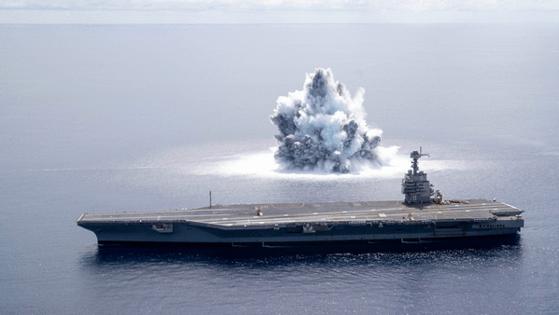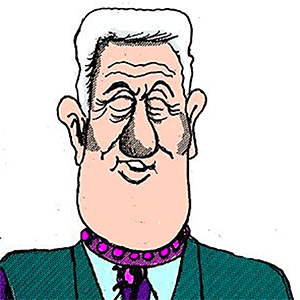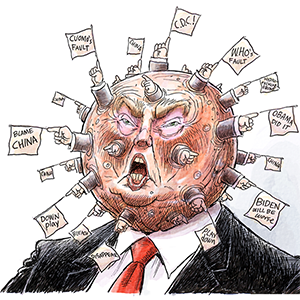U.S. aircraft carrier arrives in Caribbean region, escalating standoff with Maduro
Published in News & Features
The world’s largest and most technologically advanced aircraft carrier, the USS Gerald R. Ford, has entered the U.S. Southern Command area of responsibility, further expanding what is already the biggest U.S. military presence in the Caribbean in decades, the Navy said Tuesday.
The deployment — officially framed as a mission against narcotics trafficking and transnational crime — comes as tensions escalate between the U.S. and Venezuela, where the Nicolás Maduro regime is rushing to reinforce a troubled Russian- and Iranian-backed air defense network.
The Ford Carrier Strike Group arrives as new antiaircraft platforms surface across Venezuela. Last week, Russian-made Buk-M2E medium-range surface-to-air missile systems were spotted inside Caracas’ La Carlota military airport, following an urgent appeal by Maduro for Moscow and Beijing to help prepare for what he describes as the threat of a U.S. invasion.
The Buk-M2E, known by NATO as the SA-17 Grizzly, can engage multiple aircraft, helicopters and cruise missiles simultaneously with its 9M317E interceptor, which has a range of up to 28 miles.
Major U.S. buildup
The Ford strike group, consisting of guided-missile destroyers USS Bainbridge, USS Mahan and USS Winston S. Churchill, was ordered into the region after Secretary of Defense Pete Hegseth directed additional forces to support President Donald Trump’s mandate to dismantle transnational criminal organizations and counter narco-terrorism threatening the U.S. homeland.
“The enhanced U.S. force presence in the SOUTHCOM AOR will bolster U.S. capacity to detect, monitor, and disrupt illicit actors and activities that compromise the safety and prosperity of the United States homeland,” Pentagon spokesperson Sean Parnell said in a Navy press release. “These forces will enhance and augment existing capabilities to disrupt narcotics trafficking and degrade and dismantle TCOs.”
With more than 4,000 sailors and dozens of tactical aircraft, the Ford gives U.S. commanders unmatched reach for sustained operations at sea. Its electromagnetic catapult and advanced arresting gear allow simultaneous launches and recoveries of aircraft, offering a significant edge in both combat and surveillance missions.
The carrier will operate alongside the Iwo Jima Amphibious Ready Group and its Marine Expeditionary Unit, under a joint task force said to be focused on dismantling criminal networks using maritime routes in the Caribbean and along the coasts of Central and South America.
“Through unwavering commitment and the precise use of our forces, we stand ready to combat the transnational threats that seek to destabilize our region,” said Adm. Alvin Holsey, commander of the Doral-based Southern Command.
What the Ford brings to the table:
The Ford Strike Group carries a formidable mix of air, surface and electronic-warfare assets. Its embarked Carrier Air Wing 8 includes:
—F/A-18E/F Super Hornets
—E/A-18G Growlers
—E-2D Advanced Hawkeyes
—MH-60S and MH-60R Seahawks
—C-2A Greyhounds
The accompanying destroyers bring layered air, surface and submarine defenses through the Aegis Combat System. The USS Winston S. Churchill, serving as Integrated Air and Missile Defense Commander, provides protection against long-range aerial threats.
Venezuela builds its own shield
The U.S. show of force has further strained relations with Caracas, with Maduro accusing Washington of planning “acts of aggression” under the guise of counter-narcotics missions. Since late September, Venezuela has been in a state of emergency, mobilized its armed forces and Bolivarian Militia, and unveiled what analysts describe as one of the most integrated — though unevenly functioning — air defense networks in Latin America.
At its core are Russian-built S-300VM long-range missile systems capable of intercepting aircraft and ballistic missiles more than 125 miles away. Analysts believe three battalions protect Caracas and key industrial corridors. Buk-M2E, Pantsir-S1, upgraded S-125 Pechora-2M, and newly delivered Iranian Bavar-373 missile systems add medium- and short-range capacity.
For close-range defense, Venezuela has distributed thousands of Igla-S MANPADS, Russian-made shoulder-launched surface-to-air missile systems, across the country.
Russian and Iranian lifelines
Despite Venezuela’s crippling maintenance issues, Russia, Iran and China continue to support Maduro. Russian military transport aircraft reportedly delivered fresh missile components and Pantsir batteries in late October, and Russian advisers are assisting local operators. Iran has supplied Bavar-373 systems and cruise-missile technology; China contributes radars and electronic-warfare platforms.
Even with the new hardware, experts estimate that only 25%–40% of Venezuela’s radar and missile network is fully operational due to financial sanctions and a chronic shortage of spare parts. Still, the systems could challenge U.S. air operations near Venezuelan airspace.
A recent Washington Post report said Maduro urgently asked China, Russia and Iran for additional radars, drone technology, aircraft repairs and potentially more missiles. It remains unclear what Beijing has promised.
Strike speculation intensifies
Reports over the past week indicate the U.S. military is expanding its presence in the Caribbean, fueling speculation about potential strikes inside Venezuela. The Miami Herald and Wall Street Journal have reported that the Trump administration has identified Venezuelan military sites allegedly tied to drug-trafficking networks as possible bombing targets.
As Washington amasses what regional diplomats have described as an “armada,” anxiety is rising across Venezuela. Many citizens view the Ford’s arrival as a symbolic turning point that could signal the next phase of Trump’s pressure campaign.
Speaking last week by video at the America Business Forum in Miami, top opposition leader María Corina Machado, Venezuela’s 2025 Nobel Peace Prize laureate, endorsed Trump’s approach, calling it “absolutely correct” and a watershed in the hemisphere’s fight against tyranny and organized crime.
In August, U.S. Attorney General Pam Bondi doubled the reward for Maduro’s capture to $50 million, calling him “one of the world’s biggest drug traffickers” and the leader of the Cartel de los Soles. Bondi said he works with groups including Venezuela’s Tren de Aragua, Mexico’s Sinaloa Cartel and other transnational criminal networks.
_____
©2025 Miami Herald. Visit miamiherald.com. Distributed by Tribune Content Agency, LLC.







Comments